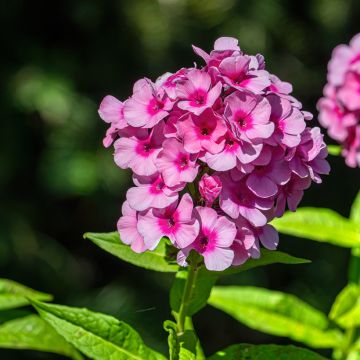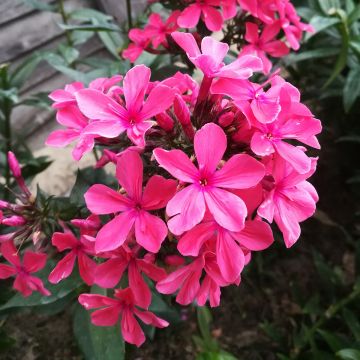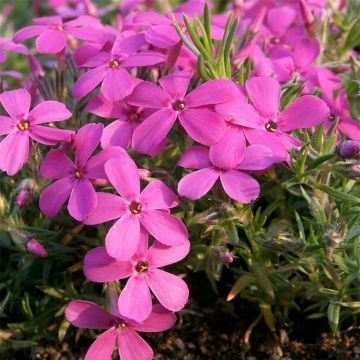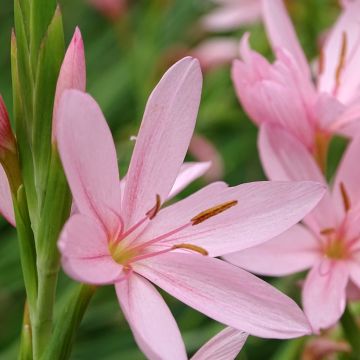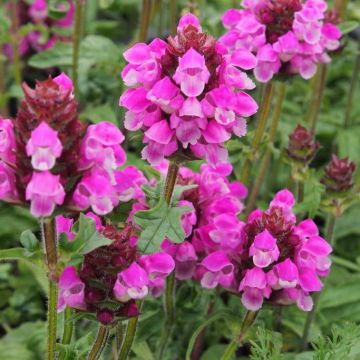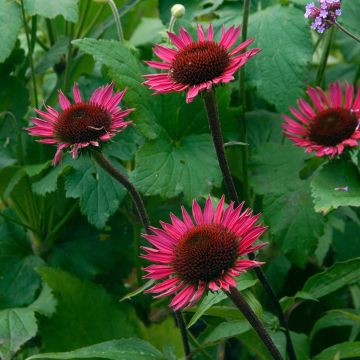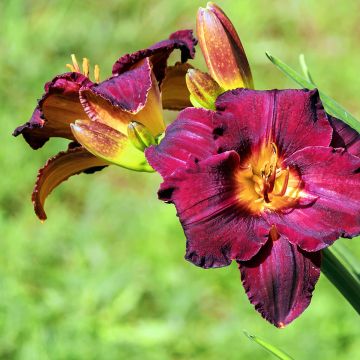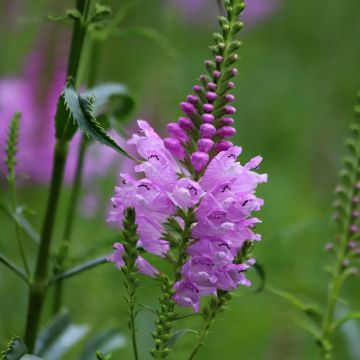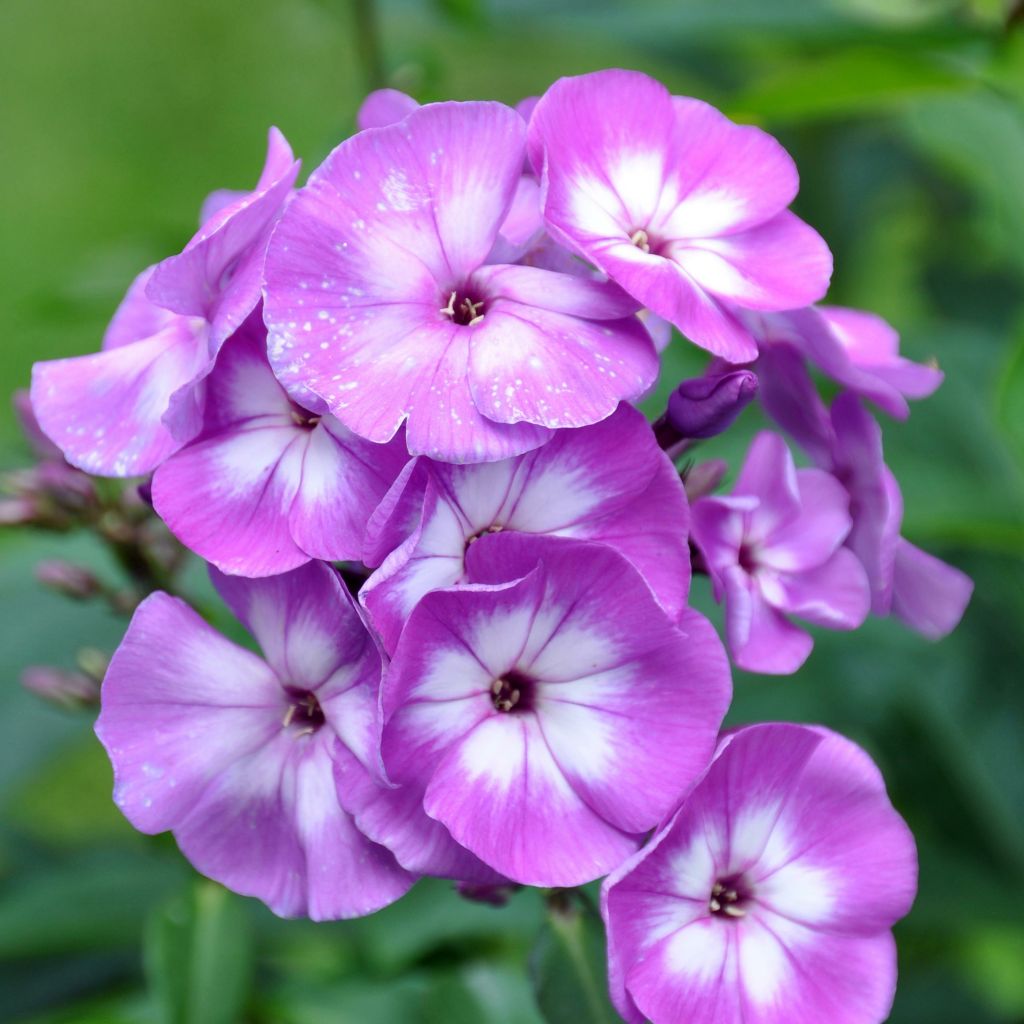

Phlox paniculata Little Laura
Phlox paniculata Little Laura
Phlox paniculata Little Laura
Garden Phlox, Summer Phlox, Perennial Phlox
This item cannot be shipped to the selected country
Delivery charge from €5.90
Delivery charge from €5.90
More information
Schedule delivery date,
and select date in basket
This plant carries a 12 months recovery warranty
More information
We guarantee the quality of our plants for a full growing cycle, and will replace at our expense any plant that fails to recover under normal climatic and planting conditions.
From €5.90 for pickup delivery and €6.90 for home delivery
Express home delivery from €8.90.
From €5.90 for pickup delivery and €6.90 for home delivery
Express home delivery from €8.90.
Does this plant fit my garden?
Set up your Plantfit profile →
Description
Phlox paniculata 'Little Laura' is a small sister of Phlox paniculata 'Laura'. It does not exceed 60 cm (24in) in height. It offers the same magenta pink flowers with white centres, grouped in voluminous fragrant panicles, on sturdy stems adorned with narrow, dark green foliage that is very healthy. It blooms all summer and into autumn. This phlox can be planted in the foreground or in the middle of a flowerbed, as well as along borders, in sunny locations and in moist soil.
Phlox paniculata 'Little Laura' belongs to the Polemoniaceae family. It is an easy-to-grow and undemanding variety, derived from Phlox paniculata, native to fertile and damp prairies in the eastern United States. 'Little Laura' is a Dutch creation by Mr. Vester in 2000. It is a perennial herbaceous plant with a woody base that slowly forms a compact clump of leafy stems reaching a height of 60 cm (24in) and a width of 40 to 50 cm (16 to 20in). The stems, rigid and sturdy, do not require staking. They are covered with 12 cm (5in) long, alternate, simple, narrow, lanceolate, dark green leaves that are very elegant. The particularly long flowering period begins in early July, at the height of summer, and continues until October, provided that faded inflorescences are removed. The flowers have a tubular corolla of bright and vibrant colours, ranging from magenta pink to fuchsia, surrounding a white central zone, centered around a tiny black eye. They are grouped at the tips of the stems in dense and fragrant panicles, reaching a length of 20 cm (8in), which gracefully bend the stems. The flowering is melliferous and nectariferous.
This 'Little Laura' phlox thrives in a sunny position, although it can tolerate some shade. Its compact size makes it a good plant for foreground planting in flowerbeds, borders, or containers in all gardens, even the smallest ones. In cottage gardens, where they are commonly found, as well as in romantic-inspired flowerbeds or cottage gardens, phlox offers a long and generous flowering period. They blend well with flowers of different shapes, lighter in appearance, such as Liatris spicata, Heleniums, Asters, and the small purple heads of Allium sphaerocephalon. White flowers, echoing the white accents of 'Little Laura', such as white roses or gauras, will make good companions. In a colourful mixed border, add daylilies, pink or purple heucheras, and echinaceas.
Report an error about the product description
Flowering
Foliage
Plant habit
Botanical data
Phlox
paniculata
Little Laura
Polemoniaceae
Garden Phlox, Summer Phlox, Perennial Phlox
Cultivar or hybrid
Other Phlox
Planting and care
Phlox paniculata are easy-to-grow plants in full sun, in deep ordinary soil that does not dry out. The 'Little Laura' phlox prefers a damp and rich soil, even clay which is well drained. It needs sun to flower well. A too dry or too hot environment makes the foliage more susceptible to powdery mildew. If planted in the sun in a climate with hot summers, it will require regular watering and mulching at the base. Pruning faded flowers promotes a second flowering at the end of the season. Protect young plants from slugs, which are fond of their tender shoots.
Planting period
Intended location
Care
This item has not been reviewed yet - be the first to leave a review about it.
Summer flowering perennials
Haven't found what you were looking for?
Hardiness is the lowest winter temperature a plant can endure without suffering serious damage or even dying. However, hardiness is affected by location (a sheltered area, such as a patio), protection (winter cover) and soil type (hardiness is improved by well-drained soil).

Photo Sharing Terms & Conditions
In order to encourage gardeners to interact and share their experiences, Promesse de fleurs offers various media enabling content to be uploaded onto its Site - in particular via the ‘Photo sharing’ module.
The User agrees to refrain from:
- Posting any content that is illegal, prejudicial, insulting, racist, inciteful to hatred, revisionist, contrary to public decency, that infringes on privacy or on the privacy rights of third parties, in particular the publicity rights of persons and goods, intellectual property rights, or the right to privacy.
- Submitting content on behalf of a third party;
- Impersonate the identity of a third party and/or publish any personal information about a third party;
In general, the User undertakes to refrain from any unethical behaviour.
All Content (in particular text, comments, files, images, photos, videos, creative works, etc.), which may be subject to property or intellectual property rights, image or other private rights, shall remain the property of the User, subject to the limited rights granted by the terms of the licence granted by Promesse de fleurs as stated below. Users are at liberty to publish or not to publish such Content on the Site, notably via the ‘Photo Sharing’ facility, and accept that this Content shall be made public and freely accessible, notably on the Internet.
Users further acknowledge, undertake to have ,and guarantee that they hold all necessary rights and permissions to publish such material on the Site, in particular with regard to the legislation in force pertaining to any privacy, property, intellectual property, image, or contractual rights, or rights of any other nature. By publishing such Content on the Site, Users acknowledge accepting full liability as publishers of the Content within the meaning of the law, and grant Promesse de fleurs, free of charge, an inclusive, worldwide licence for the said Content for the entire duration of its publication, including all reproduction, representation, up/downloading, displaying, performing, transmission, and storage rights.
Users also grant permission for their name to be linked to the Content and accept that this link may not always be made available.
By engaging in posting material, Users consent to their Content becoming automatically accessible on the Internet, in particular on other sites and/or blogs and/or web pages of the Promesse de fleurs site, including in particular social pages and the Promesse de fleurs catalogue.
Users may secure the removal of entrusted content free of charge by issuing a simple request via our contact form.
The flowering period indicated on our website applies to countries and regions located in USDA zone 8 (France, the United Kingdom, Ireland, the Netherlands, etc.)
It will vary according to where you live:
- In zones 9 to 10 (Italy, Spain, Greece, etc.), flowering will occur about 2 to 4 weeks earlier.
- In zones 6 to 7 (Germany, Poland, Slovenia, and lower mountainous regions), flowering will be delayed by 2 to 3 weeks.
- In zone 5 (Central Europe, Scandinavia), blooming will be delayed by 3 to 5 weeks.
In temperate climates, pruning of spring-flowering shrubs (forsythia, spireas, etc.) should be done just after flowering.
Pruning of summer-flowering shrubs (Indian Lilac, Perovskia, etc.) can be done in winter or spring.
In cold regions as well as with frost-sensitive plants, avoid pruning too early when severe frosts may still occur.
The planting period indicated on our website applies to countries and regions located in USDA zone 8 (France, United Kingdom, Ireland, Netherlands).
It will vary according to where you live:
- In Mediterranean zones (Marseille, Madrid, Milan, etc.), autumn and winter are the best planting periods.
- In continental zones (Strasbourg, Munich, Vienna, etc.), delay planting by 2 to 3 weeks in spring and bring it forward by 2 to 4 weeks in autumn.
- In mountainous regions (the Alps, Pyrenees, Carpathians, etc.), it is best to plant in late spring (May-June) or late summer (August-September).
The harvesting period indicated on our website applies to countries and regions in USDA zone 8 (France, England, Ireland, the Netherlands).
In colder areas (Scandinavia, Poland, Austria...) fruit and vegetable harvests are likely to be delayed by 3-4 weeks.
In warmer areas (Italy, Spain, Greece, etc.), harvesting will probably take place earlier, depending on weather conditions.
The sowing periods indicated on our website apply to countries and regions within USDA Zone 8 (France, UK, Ireland, Netherlands).
In colder areas (Scandinavia, Poland, Austria...), delay any outdoor sowing by 3-4 weeks, or sow under glass.
In warmer climes (Italy, Spain, Greece, etc.), bring outdoor sowing forward by a few weeks.

































